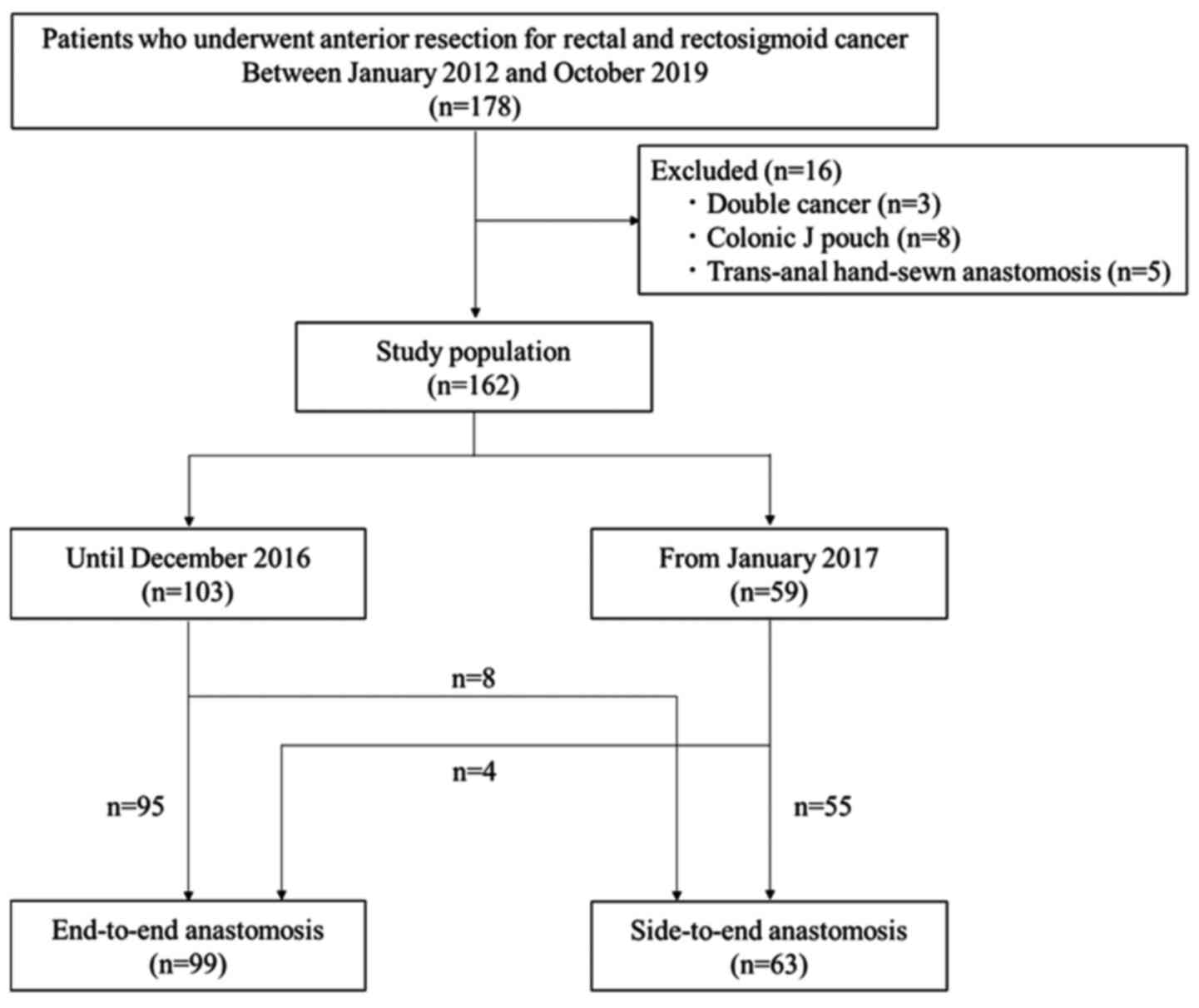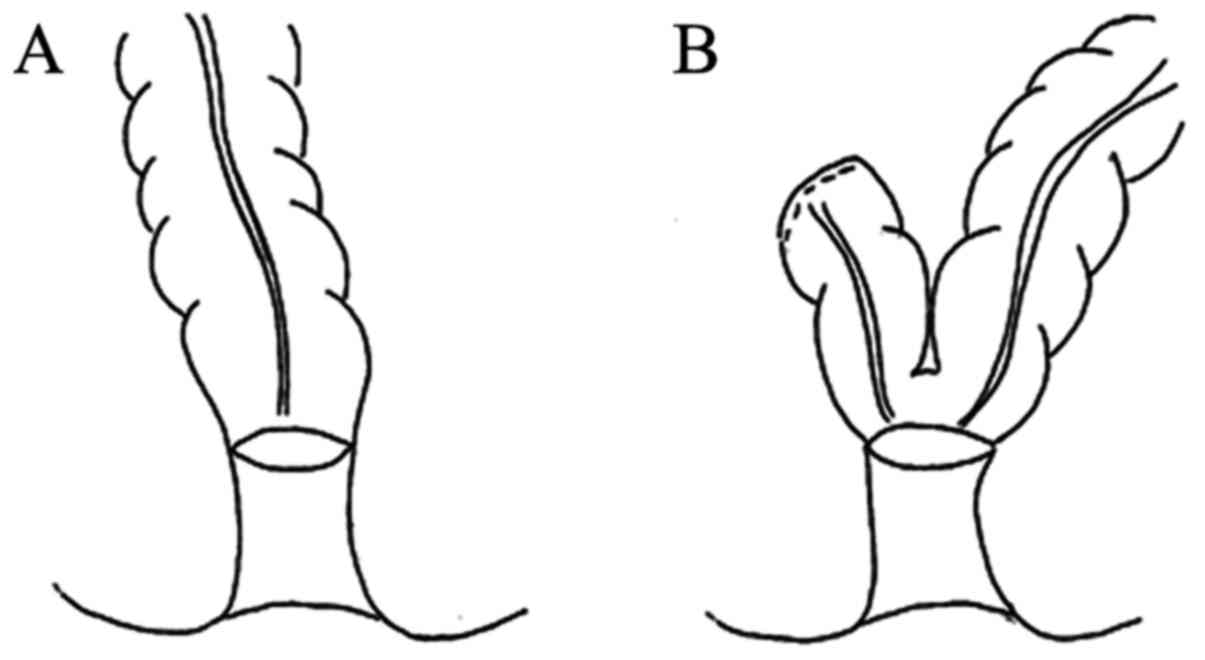|
1
|
Ortiz H, Wibe A, Ciga MA, Kreisler E,
Garcia-Granero E, Roig JV and Biondo S: Spanish Rectal Cancer
Project. Multicenter study of outcome in relation to the type of
resection in rectal cancer. Dis Colon Rectum. 57:811–822.
2014.PubMed/NCBI View Article : Google Scholar
|
|
2
|
van der Pas MH, Haglind E, Cuesta MA,
Fürst A, Lacy AM, Hop WC and Bonjer HJ: COlorectal cancer
Laparoscopic or Open Resection II (COLOR II) Study Group.
Laparoscopic versus open surgery for rectal cancer (COLOR II):
Short-term outcomes of a randomised, phase 3 trial. Lancet Oncol.
14:210–218. 2013.PubMed/NCBI View Article : Google Scholar
|
|
3
|
Park JS, Choi GS, Kim SH, Kim HR, Kim NK,
Lee KY, Kang SB, Kim JY, Lee KY, Kim BC, et al: Multicenter
analysis of risk factors for anastomotic leakage after laparoscopic
rectal cancer excision: The Korean laparoscopic colorectal surgery
study group. Ann Surg. 257:665–671. 2013.PubMed/NCBI View Article : Google Scholar
|
|
4
|
Rahbari NN, Weitz J, Hohenberger W, Heald
RJ, Moran B, Ulrich A, Holm T, Wong WD, Tiret E, Moriya Y, et al:
Definition and grading of anastomotic leakage following anterior
resection of the rectum: A proposal by the International Study
Group of Rectal Cancer. Surgery. 147:339–351. 2010.PubMed/NCBI View Article : Google Scholar
|
|
5
|
Rullier E, Laurent C, Garrelon JL, Michel
P, Saric J and Parneix M: Risk factors for anastomotic leakage
after resection of rectal cancer. Br J Surg. 85:355–358.
1998.PubMed/NCBI View Article : Google Scholar
|
|
6
|
Chang SC, Lin JK, Yang SH, Jiang JK, Chen
WC and Lin TC: Long-term outcome of anastomosis leakage after
curative resection for mid and low rectal cancer.
Hepatogastroenterology. 50:1898–1902. 2003.PubMed/NCBI
|
|
7
|
Dehni N, Parc R and Church JM: Colonic
J-pouch-anal anastomosis for rectal cancer. Dis Colon Rectum.
46:667–675. 2003.PubMed/NCBI View Article : Google Scholar
|
|
8
|
Sciuto A, Merola G, De Palma GD, Sodo M,
Pirozzi F, Bracale UM and Bracale U: Predictive factors for
anastomotic leakage after laparoscopic colorectal surgery. World J
Gastroenterol. 24:2247–2260. 2018.PubMed/NCBI View Article : Google Scholar
|
|
9
|
Akiyoshi T, Ueno M, Fukunaga Y, Nagayama
S, Fujimoto Y, Konishi T, Kuroyanagi H and Yamaguchi T: Effect of
body mass index on short-term outcomes of patients undergoing
laparoscopic resection for colorectal cancer: A single institution
experience in Japan. Surg Laparosc Endosc Percutan Tech.
21:409–414. 2011.PubMed/NCBI View Article : Google Scholar
|
|
10
|
Hamabe A, Ito M, Nishigori H, Nishizawa Y
and Sasaki T: Preventive effect of diverting stoma on anastomotic
leakage after laparoscopic low anterior resection with double
stapling technique reconstruction applied based on risk
stratification. Asian J Endosc Surg. 11:220–226. 2018.PubMed/NCBI View Article : Google Scholar
|
|
11
|
Tanaka K, Okuda J, Yamamoto S, Ito M,
Sakamoto K, Kokuba Y, Yoshimura K and Watanabe M: Risk factors for
anastomotic leakage after laparoscopic surgery with the double
stapling technique for stage 0/I rectal carcinoma: A subgroup
analysis of a multicenter, single-arm phase II trial. Surg Today.
47:1215–1222. 2017.PubMed/NCBI View Article : Google Scholar
|
|
12
|
Moran BJ: Predicting the risk and
diminishing the consequences of anastomotic leakage after anterior
resection for rectal cancer. Acta Chir Iugosl. 57:47–50.
2010.PubMed/NCBI View Article : Google Scholar
|
|
13
|
Testini M, Margari A, Amoruso M, Lissidini
G and Bonomo GM: The dehiscence of colorectal anastomoses: The risk
factors. Ann Ital Chir. 71:433–440. 2000.PubMed/NCBI(In Italian).
|
|
14
|
Hallböök O, Johansson K and Sjödahl R:
Laser Doppler blood flow measurement in rectal resection for
carcinoma - comparison between the straight and colonic J pouch
reconstruction. Br J Surg. 83:389–392. 1996.PubMed/NCBI View Article : Google Scholar
|
|
15
|
Dennett ER and Parry BR: Misconceptions
about the colonic J-pouch: What the accumulating data show. Dis
Colon Rectum. 42:804–811. 1999.PubMed/NCBI View Article : Google Scholar
|
|
16
|
Floodeen H, Hallböök O, Rutegård J,
Sjödahl R and Matthiessen P: Early and late symptomatic anastomotic
leakage following low anterior resection of the rectum for cancer:
Are they different entities? Colorectal Dis. 15:334–340.
2013.PubMed/NCBI View Article : Google Scholar
|
|
17
|
Chung RS: Blood flow in colonic
anastomoses. Effect of stapling and suturing. Ann Surg.
206:335–339. 1987.PubMed/NCBI View Article : Google Scholar
|
|
18
|
Qu H, Liu Y and Bi DS: Clinical risk
factors for anastomotic leakage after laparoscopic anterior
resection for rectal cancer: A systematic review and meta-analysis.
Surg Endosc. 29:3608–3617. 2015.PubMed/NCBI View Article : Google Scholar
|
|
19
|
Rubin F, Douard R and Wind P: The
functional outcomes of coloanal and low colorectal anastomoses with
reservoirs after low rectal cancer resections. Am Surg.
80:1222–1229. 2014.PubMed/NCBI
|
|
20
|
Hüttner FJ, Tenckhoff S, Jensen K, Uhlmann
L, Kulu Y, Büchler MW, Diener MK and Ulrich A: Meta-analysis of
reconstruction techniques after low anterior resection for rectal
cancer. Br J Surg. 102:735–745. 2015.PubMed/NCBI View
Article : Google Scholar
|
|
21
|
Rybakov EG, Pikunov DY, Fomenko OY,
Chernyshov SV and Shelygin YA: Side-to-end vs. straight stapled
colorectal anastomosis after low anterior resection: Results of
randomized clinical trial. Int J Colorectal Dis. 31:1419–1426.
2016.PubMed/NCBI View Article : Google Scholar
|
|
22
|
Seike K, Koda K, Saito N, Oda K, Kosugi C,
Shimizu K and Miyazaki M: Laser Doppler assessment of the influence
of division at the root of the inferior mesenteric artery on
anastomotic blood flow in rectosigmoid cancer surgery. Int J
Colorectal Dis. 22:689–697. 2007.PubMed/NCBI View Article : Google Scholar
|
|
23
|
Akagi T, Inomata M, Hara T, Mizusawa J,
Katayama H, Shida D, Ohue M, Ito M, Kinugasa Y, Saida Y, et al:
Clinical impact of D3 lymph node dissection with left colic artery
(LCA) preservation compared to D3 without LCA preservation:
Exploratory subgroup analysis of data from JCOG0404. Ann
Gastroenterol Surg. 4:163–169. 2020.PubMed/NCBI View Article : Google Scholar
|
|
24
|
Bertelsen CA, Andreasen AH, Jørgensen T
and Harling H: Danish Colorectal Cancer Group. Anastomotic leakage
after anterior resection for rectal cancer: Risk factors.
Colorectal Dis. 12:37–43. 2010.PubMed/NCBI View Article : Google Scholar
|
|
25
|
Richards CH, Campbell V, Ho C, Hayes J,
Elliott T and Thompson-Fawcett M: Smoking is a major risk factor
for anastomotic leak in patients undergoing low anterior resection.
Colorectal Dis. 14:628–633. 2012.PubMed/NCBI View Article : Google Scholar
|
|
26
|
Kim MJ, Shin R, Oh HK, Park JW, Jeong SY
and Park JG: The impact of heavy smoking on anastomotic leakage and
stricture after low anterior resection in rectal cancer patients.
World J Surg. 35:2806–2810. 2011.PubMed/NCBI View Article : Google Scholar
|
|
27
|
Kruschewski M, Rieger H, Pohlen U, Hotz HG
and Buhr HJ: Risk factors for clinical anastomotic leakage and
postoperative mortality in elective surgery for rectal cancer. Int
J Colorectal Dis. 22:919–927. 2007.PubMed/NCBI View Article : Google Scholar
|
|
28
|
Vignali A, Gianotti L, Braga M, Radaelli
G, Malvezzi L and Di Carlo V: Altered microperfusion at the rectal
stump is predictive for rectal anastomotic leak. Dis Colon Rectum.
43:76–82. 2000.PubMed/NCBI View Article : Google Scholar
|
|
29
|
Fawcett A, Shembekar M, Church JS,
Vashisht R, Springall RG and Nott DM: Smoking, hypertension, and
colonic anastomotic healing; a combined clinical and
histopathological study. Gut. 38:714–718. 1996.PubMed/NCBI View Article : Google Scholar
|
|
30
|
Emmanuel AV and Kamm MA: Laser Doppler
measurement of rectal mucosal blood flow. Gut. 45:64–69.
1999.PubMed/NCBI View Article : Google Scholar
|
|
31
|
Parc Y, Ruppert R, Fuerst A, Golcher H,
Zutshi M, Hull T, Tiret E, Hemminger F, Galandiuk S, Fender S, et
al: Better Function With a Colonic J-Pouch or a Side-to-end
Anastomosis?: A randomized controlled trial to compare the
complications, functional outcome, and quality of life in patients
with low rectal cancer after a J-Pouch or a side-to-end
anastomosis. Ann Surg. 269:815–826. 2019.PubMed/NCBI View Article : Google Scholar
|
|
32
|
Machado M, Nygren J, Goldman S and
Ljungqvist O: Similar outcome after colonic pouch and side-to-end
anastomosis in low anterior resection for rectal cancer: A
prospective randomized trial. Ann Surg. 238:214–220.
2003.PubMed/NCBI View Article : Google Scholar
|
|
33
|
Machado M, Nygren J, Goldman S and
Ljungqvist O: Functional and physiologic assessment of the colonic
reservoir or side-to-end anastomosis after low anterior resection
for rectal cancer: A two-year follow-up. Dis Colon Rectum.
48:29–36. 2005.PubMed/NCBI View Article : Google Scholar
|
|
34
|
Siddiqui MR, Sajid MS, Woods WG, Cheek E
and Baig MK: A meta-analysis comparing side to end with colonic
J-pouch formation after anterior resection for rectal cancer. Tech
Coloproctol. 14:113–123. 2010.PubMed/NCBI View Article : Google Scholar
|
|
35
|
Fazio VW, Zutshi M, Remzi FH, Parc Y,
Ruppert R, Fürst A, Celebrezze J Jr, Galanduik S, Orangio G, Hyman
N, et al: A randomized multicenter trial to compare long-term
functional outcome, quality of life, and complications of surgical
procedures for low rectal cancers. Ann Surg. 246:481–490.
2007.PubMed/NCBI View Article : Google Scholar
|
















